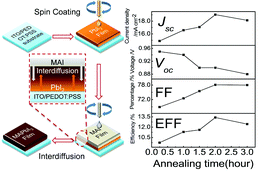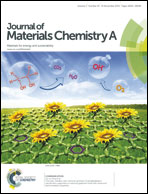Understanding the formation and evolution of interdiffusion grown organolead halide perovskite thin films by thermal annealing†
Abstract
Organolead trihalide perovskites are emerging excellent active materials for thin film solar cells. Here, the formation and evolution of methylammonium lead iodide perovskite thin films grown by the low-temperature thermal annealing induced interdiffusion process are investigated. It is found that thermal annealing not only drives the formation of perovskite but also affects the morphology, optoelectronic properties and correlated device performance. Thermal annealing at 105 °C quickly drives the formation of phase-pure perovskite in a short time of 15 min, and continued thermal annealing up to two hours continuously increases the perovskite crystallinity and grain size without losing film continuity or coverage. The measured Hall mobility increases monotonically to 36.0 cm2 V−1 s−1 upon annealing, which is correlated with the increased crystallinity and grain size. Device efficiencies increase with an increased short circuit current density and fill factor with a longer annealing time up to two hours, and the highest device efficiency of 13.4% is achieved. It is found that the reduction of work function in the perovskite films, caused by the increased annealing duration, is linearly correlated with the open circuit voltage loss, which points out a path for the further increase of the device efficiency.


 Please wait while we load your content...
Please wait while we load your content...